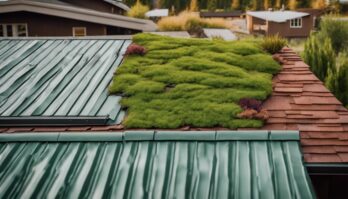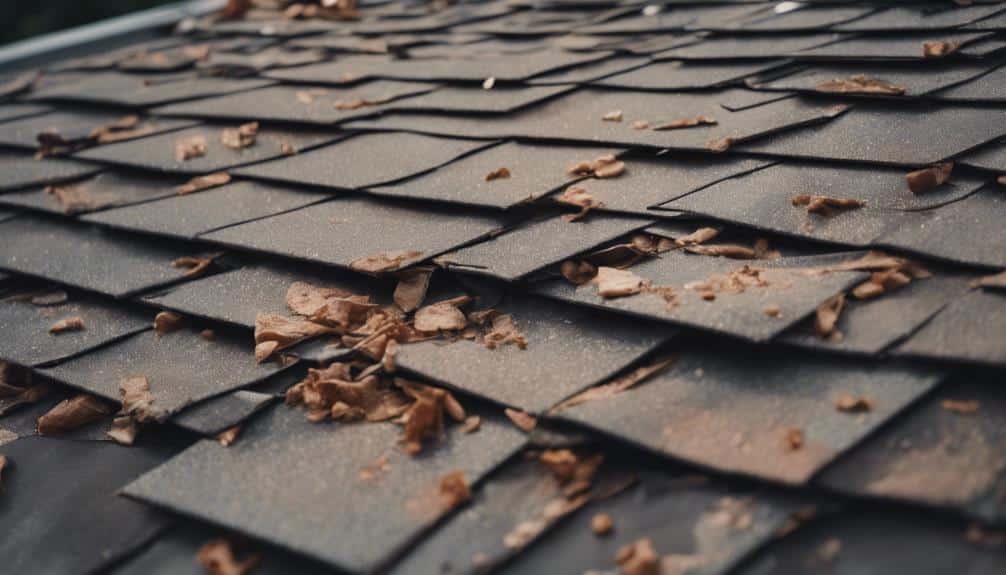
Driving through a storm can feel like steering through a turbulent sea, with each gust of wind threatening to capsize. When a storm damages your roof, the chaos above can be just as unsettling. But what exactly does storm damage roof repair involve? The process goes beyond merely patching up visible cracks; it entails a detailed evaluation of the entire roofing system. From identifying hidden structural issues to choosing the right materials for repair, each step is essential in restoring your roof's integrity.
Key Takeaways
- Assess roof damage for cracks, missing shingles, and water penetration signs.
- Implement temporary weatherproofing measures like roof tarps and leak prevention.
- Document damage thoroughly for insurance claims and select durable, compatible repair materials.
- Address structural damage with reinforcements and waterproofing for long-term integrity.
Assessing Roof Damage
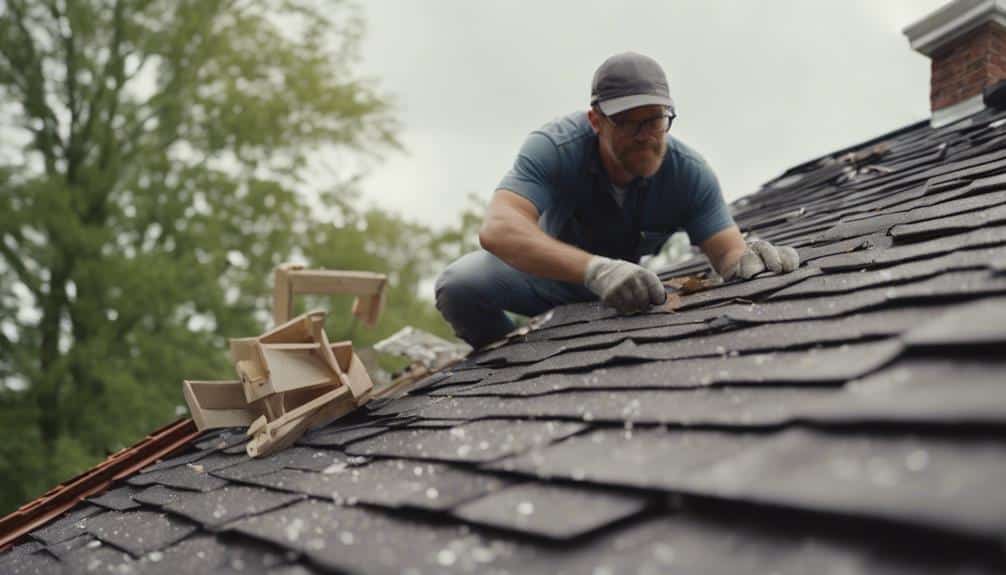
When evaluating roof damage after a storm, the first step is to carefully inspect the shingles for any signs of cracks, tears, or missing pieces. Roof inspection is important in determining the extent of the damage. Look for areas where the shingles are lifted or curled, as these could indicate water penetration. Additionally, check for any granules from the shingles in the gutters or on the ground, as this could be a sign of significant wear. Damage assessment involves examining the flashing around chimneys, vents, and skylights for any gaps or cracks. It is essential to document all observed damage thoroughly, as this information will guide the repair process. Conducting a thorough roof inspection is key to ensuring the proper repair of storm damage.
Temporary Weatherproofing Measures
After evaluating the roof damage caused by the storm, the next step involves implementing temporary weatherproofing measures to prevent further deterioration. This typically includes utilizing roof tarps to cover exposed areas and prevent water infiltration, as well as conducting emergency repairs to address immediate issues. Waterproofing techniques are essential to safeguard the interior of the property from additional harm until permanent repairs can be made. These temporary measures are important in minimizing the extent of the damage and protecting the structural integrity of the building. Here's a table to showcase some common temporary weatherproofing measures:
| Temporary Weatherproofing Measures | ||
|---|---|---|
| 1. Roof Tarps | 2. Leak Prevention | |
| 3. Emergency Repairs | 4. Waterproofing Techniques | |
| 5. Structural Integrity Protection |
Documentation for Insurance Claims
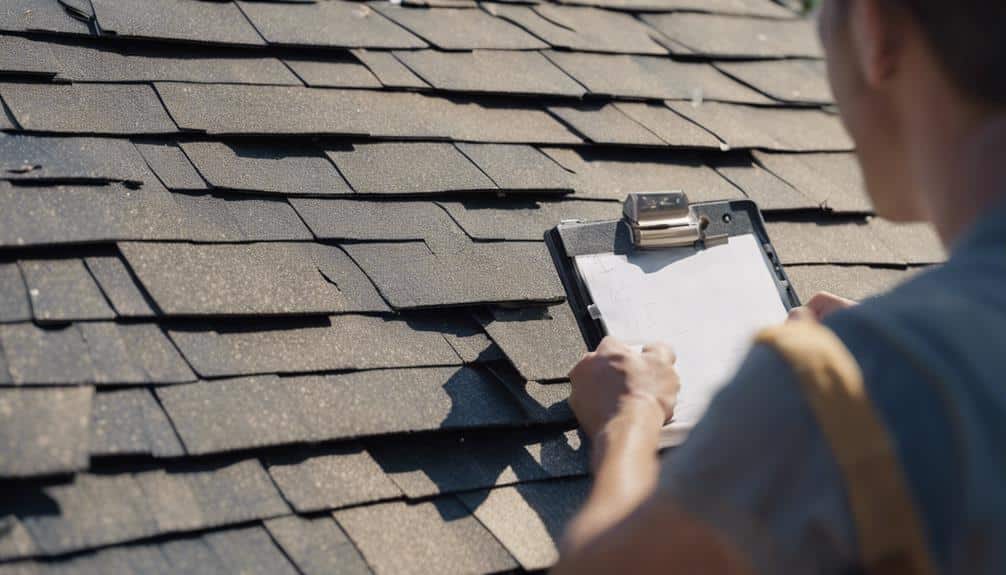
To guarantee a smooth insurance claims process after storm damage, thorough documentation of the roof damage is essential. When dealing with insurance claims for storm-damaged roofs, attention to detail in documenting the extent of the damage can have a substantial impact on the outcome of your claim. Here are some key points to ponder:
- Capture clear photographs from multiple angles to show the full scope of the damage.
- Keep detailed records of any communication with your insurance company throughout the claim process.
- Collect any relevant receipts or invoices for repairs or temporary weatherproofing measures.
- Consider seeking professional assistance to make sure all evidence collection meets the insurance company's requirements.
Selecting Materials for Repair
When selecting materials for storm damage roof repair, it's important to evaluate factors like durability, compatibility, and cost-effectiveness. Ensuring the chosen materials are durable enough to withstand future weather events is key to a successful repair. Additionally, compatibility with existing materials and evaluating cost-effectiveness will help in making the best decision for your roof repair needs.
Material Selection Considerations
Amidst storm damage roof repair, it is important to carefully select materials that will guarantee long-lasting durability and effective protection for your property. When choosing materials for repair, consider the following:
- Material Durability: Opt for high-quality materials that can withstand harsh weather conditions and provide lasting protection.
- Color Options: Explore a variety of colors to match your property's aesthetic while ensuring durability.
- Compatibility: Make sure that the materials you choose are compatible with your existing roof structure to prevent future issues.
- Energy Efficiency: Consider materials that offer energy-saving benefits to improve the overall efficiency of your property.
Durability and Compatibility
Selecting materials for storm damage roof repair requires careful consideration of both durability and compatibility to guarantee long-term protection and structural integrity. Durability testing is essential to make sure that the materials can withstand harsh weather conditions and potential future storms. It is important to choose materials that are not only durable on their own but also compatible with the existing roof structure to prevent issues like leaks or improper installation. Evaluating material compatibility involves examining factors such as the type of roofing system, pitch, and environmental conditions to determine the best fit. By prioritizing durability testing and material compatibility during the selection process, you can help ensure that your roof repair will be effective in providing lasting protection for your home.
Cost-Effectiveness Assessment
In evaluating the cost-effectiveness of materials for roof repair, careful consideration of long-term value and performance is important. When determining the best materials for the repair, several factors come into play:
- Cost analysis: Comparing the initial costs of different materials.
- Evaluation options: Evaluating the availability and suitability of materials for the specific repair needed.
- Budget considerations: Ensuring the chosen materials align with the allocated budget for the repair.
- Repair methods: Understanding how different materials may require specific repair techniques.
Repairing or Replacing Shingles
When evaluating storm damage to a roof, the inspection process for shingles is vital to determine the extent of repair needed. Proper installation techniques are essential for guaranteeing the longevity and effectiveness of shingles in protecting the roof structure. By carefully examining the condition of the shingles and following correct installation procedures, we can guarantee a durable and secure roof.
Shingle Inspection Process
During a thorough shingle inspection process, it is essential to carefully examine each individual shingle for signs of damage or wear. Here are some key aspects to take into account during the inspection:
- Shingle Color Options: Assess if the color of the shingles remains consistent or if there are any fading or discoloration issues.
- Installation Process: Look for any improper installation signs such as missing nails, misaligned shingles, or inadequate sealing.
- Weathering: Check for any signs of weathering, such as curling edges, granule loss, or cracks.
- Water Damage: Inspect for water damage indicators like water stains, mold growth, or soft spots.
Careful evaluation of these factors can help determine whether shingles need repair or replacement after storm damage.
Proper Installation Techniques
Upon inspecting the damaged shingles, it is important to make sure that the repair or replacement process follows proper installation techniques for long-lasting results. Proper techniques and installation methods are vital to ensure the roof's integrity and durability. When repairing or replacing shingles, attention to detail is paramount. Here is a table that outlines the key steps involved in the proper installation of shingles:
| Steps | Description | Importance |
|---|---|---|
| 1. Inspection | Assess the extent of damage and type of repair | Vital for accuracy |
| 2. Preparation | Gather necessary tools and materials | Ensures efficiency |
| 3. Installation | Follow manufacturer guidelines for placement | Ensures longevity |
Addressing Structural Damage
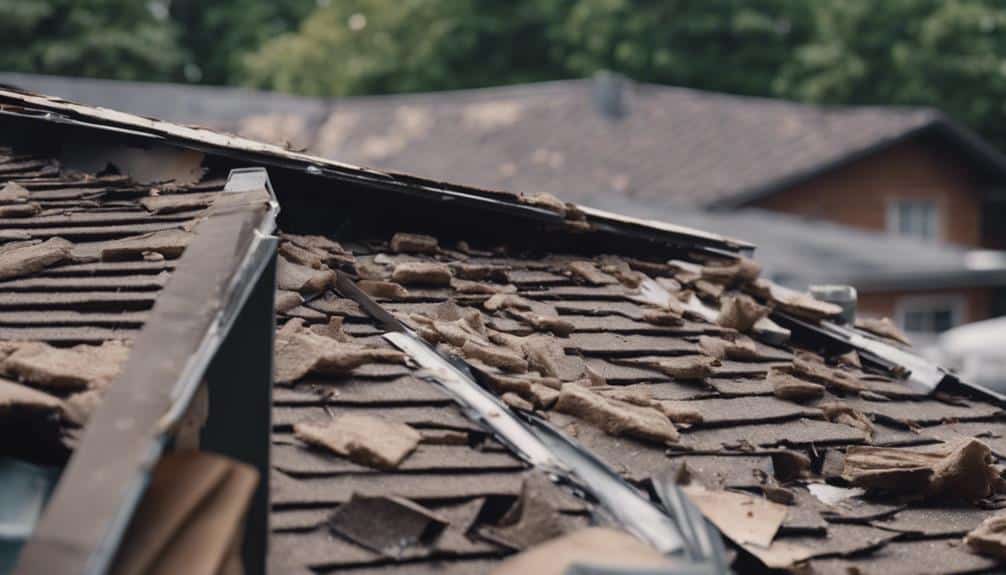
To effectively address structural damage after a storm, a thorough inspection by a qualified professional is crucial. Structural reinforcement and waterproofing solutions play a vital role in restoring the integrity of the roof. Here are key steps involved in addressing structural damage:
- Conduct a detailed assessment of the roof's support structure.
- Implement necessary reinforcements to strengthen weakened areas.
- Apply waterproofing solutions to prevent future water intrusion.
- Guarantee proper ventilation to avoid moisture buildup.
Final Inspection and Cleanup
Once the structural repairs have been completed, a meticulous final inspection and thorough cleanup are essential steps in ensuring the roof's integrity and longevity. During the final inspection, I carefully follow an inspection checklist to verify that all repairs have been executed correctly and that the roof is in best condition. This post-repair evaluation involves checking for any remaining signs of damage, ensuring proper installation of any new materials, and confirming that the roof is structurally sound. Additionally, a detailed cleanup is conducted to remove any debris, nails, or materials left behind during the repair process. By completing this final step with precision and attention to detail, I guarantee that the roof is not only repaired but also maintained to withstand future storms.
Frequently Asked Questions
Can Storm Damage to a Roof Affect the Structural Integrity of a Home?
Storm damage to a roof can indeed impact the structural integrity of a home. In such cases, it's important to promptly contact your home insurance provider. They may require a professional roof inspection to assess the extent of the damage and determine the necessary repairs. Ignoring storm damage risks further harm to the structure and could potentially lead to more costly repairs in the future.
What Are Some Common Signs of Roof Damage That May Not Be Visible Immediately After a Storm?
After a storm, immediate inspection is important. Despite a roof looking intact, hidden damage can have long-term effects. Missing shingles or leaks may not be visible right away, so post-storm care is crucial. One interesting statistic is that over 30% of roof damage goes unnoticed initially. Being proactive can prevent costly repairs later on. It's important to address any signs of damage promptly to maintain a safe home.
How Long Does It Typically Take to Complete Storm Damage Roof Repairs?
Typically, storm damage roof repairs can take anywhere from a few days to a couple of weeks, depending on the extent of the damage and the availability of materials. During this time, a detailed inspection process is carried out to assess the damage accurately. Quality assurance is paramount throughout the repair timeline, ensuring that the work meets high standards. Material selection is essential to guarantee the durability and longevity of the repaired roof.
Are There Any Preventative Measures Homeowners Can Take to Minimize the Risk of Future Storm Damage to Their Roof?
Taking proactive steps can help reduce the risk of future storm damage to your roof. Regular roof maintenance and inspections are essential in identifying potential issues early on. Weatherproofing and reinforcing vulnerable areas, such as loose shingles or weak spots, can also help strengthen your roof against severe weather conditions. By staying on top of maintenance and making necessary repairs promptly, homeowners can minimize the impact of future storms on their roofs.
Are There Any Warranties or Guarantees Offered for Storm Damage Roof Repairs?
When it comes to storm damage roof repairs, warranty coverage and repair guarantees are essential. Many reputable roofing companies offer warranties on their repair work, ensuring that you are covered if any issues arise post-repair. These warranties provide peace of mind and demonstrate the company's commitment to quality service. Additionally, repair guarantees solidify the company's promise to stand by their work, giving you confidence in the durability of the repairs.
Conclusion
To sum up, repairing storm damage to a roof is like piecing together a puzzle in a race against time. It involves carefully evaluating the damage, selecting the right materials, and addressing any structural issues. The process may seem challenging, but with the right team and plan in place, your roof will soon be as strong as a lion and ready to weather any storm that comes its way.

